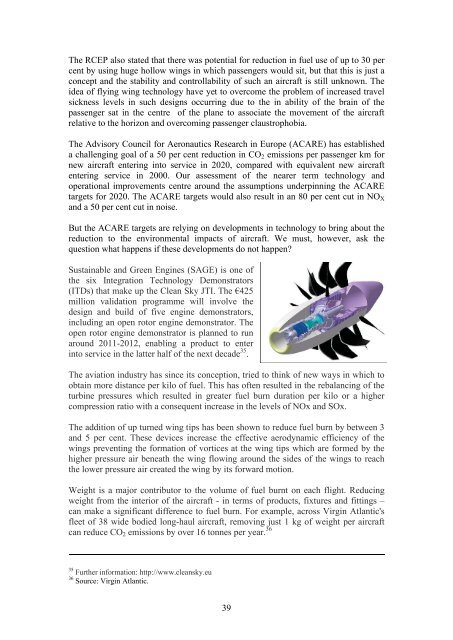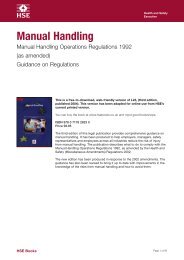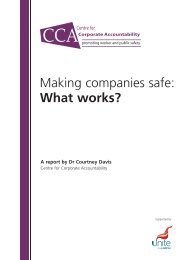Sustainable Transport and the Environment Guide - Unite the Union
Sustainable Transport and the Environment Guide - Unite the Union
Sustainable Transport and the Environment Guide - Unite the Union
You also want an ePaper? Increase the reach of your titles
YUMPU automatically turns print PDFs into web optimized ePapers that Google loves.
The RCEP also stated that <strong>the</strong>re was potential for reduction in fuel use of up to 30 per<br />
cent by using huge hollow wings in which passengers would sit, but that this is just a<br />
concept <strong>and</strong> <strong>the</strong> stability <strong>and</strong> controllability of such an aircraft is still unknown. The<br />
idea of flying wing technology have yet to overcome <strong>the</strong> problem of increased travel<br />
sickness levels in such designs occurring due to <strong>the</strong> in ability of <strong>the</strong> brain of <strong>the</strong><br />
passenger sat in <strong>the</strong> centre of <strong>the</strong> plane to associate <strong>the</strong> movement of <strong>the</strong> aircraft<br />
relative to <strong>the</strong> horizon <strong>and</strong> overcoming passenger claustrophobia.<br />
The Advisory Council for Aeronautics Research in Europe (ACARE) has established<br />
a challenging goal of a 50 per cent reduction in CO 2 emissions per passenger km for<br />
new aircraft entering into service in 2020, compared with equivalent new aircraft<br />
entering service in 2000. Our assessment of <strong>the</strong> nearer term technology <strong>and</strong><br />
operational improvements centre around <strong>the</strong> assumptions underpinning <strong>the</strong> ACARE<br />
targets for 2020. The ACARE targets would also result in an 80 per cent cut in NO X<br />
<strong>and</strong> a 50 per cent cut in noise.<br />
But <strong>the</strong> ACARE targets are relying on developments in technology to bring about <strong>the</strong><br />
reduction to <strong>the</strong> environmental impacts of aircraft. We must, however, ask <strong>the</strong><br />
question what happens if <strong>the</strong>se developments do not happen?<br />
<strong>Sustainable</strong> <strong>and</strong> Green Engines (SAGE) is one of<br />
<strong>the</strong> six Integration Technology Demonstrators<br />
(ITDs) that make up <strong>the</strong> Clean Sky JTI. The €425<br />
million validation programme will involve <strong>the</strong><br />
design <strong>and</strong> build of five engine demonstrators,<br />
including an open rotor engine demonstrator. The<br />
open rotor engine demonstrator is planned to run<br />
around 2011-2012, enabling a product to enter<br />
into service in <strong>the</strong> latter half of <strong>the</strong> next decade 35 .<br />
The aviation industry has since its conception, tried to think of new ways in which to<br />
obtain more distance per kilo of fuel. This has often resulted in <strong>the</strong> rebalancing of <strong>the</strong><br />
turbine pressures which resulted in greater fuel burn duration per kilo or a higher<br />
compression ratio with a consequent increase in <strong>the</strong> levels of NOx <strong>and</strong> SOx.<br />
The addition of up turned wing tips has been shown to reduce fuel burn by between 3<br />
<strong>and</strong> 5 per cent. These devices increase <strong>the</strong> effective aerodynamic efficiency of <strong>the</strong><br />
wings preventing <strong>the</strong> formation of vortices at <strong>the</strong> wing tips which are formed by <strong>the</strong><br />
higher pressure air beneath <strong>the</strong> wing flowing around <strong>the</strong> sides of <strong>the</strong> wings to reach<br />
<strong>the</strong> lower pressure air created <strong>the</strong> wing by its forward motion.<br />
Weight is a major contributor to <strong>the</strong> volume of fuel burnt on each flight. Reducing<br />
weight from <strong>the</strong> interior of <strong>the</strong> aircraft - in terms of products, fixtures <strong>and</strong> fittings –<br />
can make a significant difference to fuel burn. For example, across Virgin Atlantic's<br />
fleet of 38 wide bodied long-haul aircraft, removing just 1 kg of weight per aircraft<br />
can reduce CO 2 emissions by over 16 tonnes per year. 36<br />
35 Fur<strong>the</strong>r information: http://www.cleansky.eu<br />
36 Source: Virgin Atlantic.<br />
39
















